Work in Progress: Lina Karain’s day-care center for Rohingya children in Bangladesh
Lina Karain (MArch ’20) describes her final project for the option studio “Architecture as a Tool to Improve Lives: Development of a Day Care Centre for Rohingya Children” led by Anna Heringer, fall 2018.
Pioneering conceptual artist Agnes Denes addresses the students of the Harvard Graduate School of Design
For more than 50 years, artist Agnes Denes has dedicated herself to unifying disparate trajectories of knowledge across the arts and sciences into radically new forms of seeing and engaging with the world. Her work spans a range of media and scales, and engages a variety of academic disciplines, including philosophy, mathematics, and the natural and social sciences. Denes’s large-scale ecological interventions are among her most well-known projects, in particular Wheatfield–A Confrontation (1982), the now-iconic work in which she planted a two-acre wheat field in what was then a derelict lot in Lower Manhattan. No less impressive and important are her conceptual prints, which have explored among other things variations on earth’s mathematical form and visual experiments with Pascal’s Triangle. In Spring 2019, Harvard’s Graduate School of Design invited Denes to give a lecture as part of its Rouse Visiting Artist Program. When schedules did not align, she offered instead to address students through a piece of writing.
Below is her address to students, written in April 2019. To accompany the piece, Denes created an original object, a six-foot-long scroll of the manifesto she composed in 1970 and which has guided her practice ever since. An artist edition of 1,000 copies of the manifesto was designed by Zak Group and is offered as a gift to students from Denes.

“Hello you brilliant young people ready to change the world and make it a better place because you are in it, saving it from its self-inflicted wounds and self-propelled doom.
Ask yourselves: Where are you, at your age of wanting to change things?
A few words as you go on your journey:
Every word uttered today is political. There is no escaping it. The atmosphere has become contaminated.
People are fighting to be heard, using big words, tugging at heartstrings, fighting for some truth, while language itself is losing its precision.
Saying something meaningful is difficult when everybody says some of it to a degree, when all has been touched on or becomes meaningful by who says it—someone with power or a famous person. You listen to a friend, a relative, someone you trust and admire.

I am not sure how well you know me, because I am not a self-promoter, abhor politics and because we are separated by disciplines, even though we shouldn’t be. Art, science and philosophy should be together and part of all else in spite of specialization, which is the subject of one of my books.
I’ll try to offer you one true language of communication that cannot be corrupted. My art and philosophy.
When I set out on my journey I wanted to change the world, re-evaluate all knowledge and put it into visual form for better understanding. This process of evaluation and visualization would probably have taken 1,000 humans and at least as many libraries to even begin. An impossibility, so I began. This was the onset of my Early Philosophical Drawings and became my art of Visual Philosophy.
As I worked, I came to realize that my task was a little more complex than what could be accomplished by a single mind without help or funds. This did not faze me a bit and I kept going, setting and reaching milestones as I went.
I was inexperienced and fearless, willing to give up all else but my goal.
Many people do that. Scientists wanting to discover, writers educating in special terms, inventors, leaders whose motives are still pure, a few artists.
It was only when I got much older that I realized I had changed very little, that some of what I wanted to change had changed by itself. Not to say that I was useless or unneeded, just that this is the way of things. You don’t move a behemoth, it moves by its sheer volume.
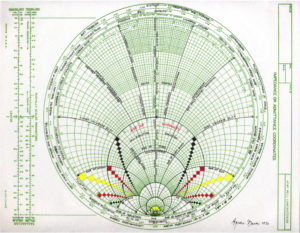
Change is the only thing you can count on. You learn how to walk without crutches, and with very little to depend on.
Even the truth, that great challenger, because it is beyond the long end of your telescope even in the land of ultimates, changes meaning, leaving many truths, and nothing to depend on.
Wanting to change the world morphed into a unique artistic output of a lifetime of creation, and the visualization of invisible processes, such as math, logic, thinking processes, and so on.
This process of re-evaluation and visualization became a process of offering humanity benign solutions to some of its problems and involved a multitude of disciplines.
So now ask yourselves, where are you at your age of wanting to change things? What mountain is left to climb, move over or eliminate?
I will not pretend to tell you ultimate truths or aims, only that you should seek them. It is this seeking that is the journey, and it is as precious as the destination.

Even if the words we seek to describe our condition have already been worked over. Even if your hope is already waning, and your innocence has already been lost, many of you still might believe you can change the world. And some of you might. A little.
Question everything. Not just because you should, but so that you might hone your ability to do so. The best creativity comes from questioning the status quo.
While you’ll never be fully free of the influences of your environment and your upbringing, deep thinking and evaluation are a necessary part of the development of your own mode of thought, be that good or bad.
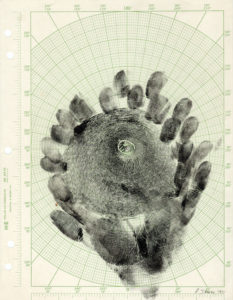
Your mind will be your salvation in a troubled world, and there will never be a time when our world is not troubled.
But don’t just live within the walls of your own mind, but also DO, because overthinking can also bring downfall. Abused, unused or overused organs offer little benefit.
Read my Manifesto that accompanies this writing. I live by it and hope you will too.
Good luck, dear future and fellow travelers on our journey of life.
Have you guessed yet what that ultimate language of communication is?
Go find your goal and create.”
Agnes Denes
April 19, 2019
The first ever retrospective of Agnes Denes’s work to be organized in New York City—Agnes Denes: Absolutes and Intermediates —will open at The Shed on October 9, 2019.
Top photograph: John McGrail. All artworks © Agnes Denes & Courtesy Leslie Tonkonow Artworks + Projects, New York. Introduction by Ken Stewart. Photographs of “Manifesto” by Maggie Janik. Special thanks to Penelope Phylactopoulos.
Sarah Whiting named next dean of Harvard Graduate School of Design

Sarah Whiting, dean of architecture at Rice University, will return to Harvard, where she taught early in her career, as the next dean of the Graduate School of Design.
Sarah Whiting, a leading scholar, educator, and architect widely respected for her commitment to integrating design theory and practice, has been named dean of the Harvard Graduate School of Design (GSD), University President Larry Bacow announced today.
A Harvard GSD faculty member early in her career, Whiting has served since 2010 as dean of the Rice University School of Architecture, where she is the William Ward Watkin Professor of Architecture. She is also co-founder and partner of WW Architecture, a firm she launched with her partner, Ron Witte, in 1999.
Whiting will assume the GSD deanship on July 1, succeeding Mohsen Mostafavi, who is stepping down after more than 11 years of distinguished service.
“Sarah Whiting is an outstanding leader with broad interests that range across the design disciplines and beyond,” said Bacow in announcing the appointment. “She has a keen understanding of the intellectual dimensions of design and its distinctive power to shape the world of ideas. And she has an equally keen understanding of design as a force for shaping the communities we inhabit and for engaging with some of contemporary society’s hardest challenges. I have been deeply impressed by her during the course of the search, and I greatly look forward to welcoming her back to Harvard.”
“The GSD has long been a center of gravity for my thinking and actions, and I’m thrilled to be returning,” Whiting said. “It is altogether tantalizing to look across the School’s three departments, with their individual and collective capacities to shape new horizons within Gund Hall. And it’s even more enticing to envision working with the GSD’s remarkable faculty, students, staff, and alumni to help imagine and create new futures for the world, not just at Harvard but beyond.”
As dean at Rice, Whiting said she has been guided by an overarching commitment to “dissolving the divide between architecture as an intellectual endeavor and architecture as a form of engaged practice.” She has led efforts to reform the curriculum, introduce innovative studio options, recruit faculty, boost funding for research and course development, enhance facilities, and raise new resources.
Her interests are broadly interdisciplinary, with the built environment at their core. An expert in architectural theory and urbanism, she has particular interest in architecture’s relationship with politics, economics, and society and how the built environment shapes the nature of public life. Her work has been published in leading journals and collections, and she is the founding editor of Point, a book series aimed at shaping contemporary discussions in architecture and urbanism.
In recent years, Whiting has been recognized as an educator of the year by the publication DesignIntelligence (2014, 2018), by Architectural Record magazine’s Women in Architecture program (2017), and by the Houston chapter of the American Institute of Architects (2016).
“Sarah Whiting has earned an extraordinary reputation as dean of the School of Architecture at Rice, where she has pursued educational innovations while building connections across the university,” said Harvard Provost Alan Garber. “She is similarly committed to strengthening connections across the departments of the GSD and between the GSD and the rest of Harvard. At a time when the role of design is increasingly important, and when design education and practice face an array of challenges, her creativity, wisdom, and leadership experience will help the GSD navigate the changing demands of the design professions and the evolving interests of our faculty and students. She is the right person to lead the School forward.”
Whiting has held many other leadership roles at Rice, chairing search committees for the dean of graduate studies, the dean of humanities, and the director of Rice’s Moody Center for the Arts. She sits on the Rice board of trustees’ buildings and grounds design subcommittee and has been active in the university’s efforts to engage with its home city of Houston.
Before becoming dean at Rice, Whiting served on the Princeton architecture faculty as assistant professor from 2005 to 2009. From 1999 to 2005, she was a design critic, assistant professor, and associate professor in the Harvard GSD’s Department of Architecture. She also has taught at the Illinois Institute of Technology, the University of Kentucky, and the University of Florida.
A graduate of Yale College, Whiting earned her MArch degree from Princeton and her PhD in architectural history, theory, and criticism from the Massachusetts Institute of Technology. Early in her career, she practiced with the architects Rem Koolhaas, Peter Eisenman, and Michael Graves.
In announcing her appointment, Bacow expressed thanks to the “many members of the GSD community — faculty, students, staff, alumni — who offered thoughtful advice during the search. Provost Alan Garber and I are grateful to all of you — and especially to our faculty advisory committee, whose members provided valuable counsel throughout. Special thanks go again to Mohsen Mostafavi, whose devoted service as dean these past 11-plus years has guided the GSD’s continuing leadership and progress.”
“Sarah Whiting is an exemplary academic leader and colleague. Her intellectual commitment to design education has enhanced the future of practice,” Mostafavi said of his successor. “I am delighted that she will be returning to the GSD to help shape the next phase of this incredible School’s journey.”
Grace La co-chairs annual Association of Collegiate Schools of Architecture conference
This March, the Harvard Graduate School of Design’s Grace La co-chaired the Association of Collegiate Schools of Architecture’s (ACSA) 107th annual conference, leading the three-day symposium at Carnegie Mellon University and a culminating exhibition, installed at the Carnegie Museum of Art. La was joined by co-chairs Jeremy Ficca, Associate Professor of Architecture at Carnegie Mellon University and director of its Design Fabrication Laboratory, and Amy Kulper, Associate Professor of Architecture and Department Head at the Rhode Island School of Design. At the GSD, La is Professor of Architecture and chair of the GSD’s Practice Platform. She also hosts the GSD podcast “Talking Practice.”
Titled “Black Box: Articulating Architecture’s Core in the Post-Digital Era,” the 2019 ACSA conference took its inspiration from architectural critic Reyner Banham’s final essay, in which he described the discipline as a black box, a device known only through its inputs and outputs, but never through its content. In the nearly 30 years since that essay’s publication, the ACSA’s 2019 conference theme responds to field’s current post-digital moment, La observes, in which design has continued to broaden its arsenal of techniques and operate across an increasingly expanded field. Amid such expansion and diversification, the conference aimed to ask what constitutes the central tasks of an architect today, and sought paper and exhibition proposals around architecture’s core assertions, approaches, and techniques.
The response to this call generated 454 paper submissions and 226 drawing submissions, totaling nearly 700 entries—the ACSA’s highest response rate in the last decade.
The conference’s subsequent exhibition, “Drawing for the Design Imaginary,” was on view at the Carnegie Museum of Art for the week following the conference. Presenting works collected from around the world, the exhibition inquired upon the role of drawing for the design imaginary, and how such drawings might scaffold contemporary design thinking and pedagogy amid ongoing advancement in technology, simulation, and modeling.
Alongside La, the conference also featured GSD faculty Antoine Picon and Toshiko Mori, honored as Plenary Keynote and Topaz Medallion awardees respectively, as well as Michelle Chang, Iman Fayyad, Andrew Holder, Max Kuo, Megan Panzano, Tom De Paor, and Sergio Lopez Pineiro. Over 30 additional GSD alums and affiliates from all degree programs participated via delivery of papers, exhibition of projects, and moderation of sessions.
In addition to her GSD work, La is founding principal of LA DALLMAN Architects, internationally recognized for the integration of architecture, engineering, and landscape. Co-founded with James Dallman, LA DALLMAN is engaged in catalytic projects of diverse scale and type. Noted for works that expand the architect’s agency in the civic recalibration of infrastructure, public space and challenging sites, LA DALLMAN was named as an Emerging Voice by the Architectural League of New York in 2010 and received the Rudy Bruner Award for Urban Excellence Silver Medal in 2007. In 2011, LA DALLMAN was the first practice in the United States to receive the Rice Design Alliance Prize, an international award recognizing exceptionally gifted architects in the early phase of their career. LA DALLMAN has also been awarded numerous professional honors, including architecture and engineering awards, as well as prizes in international design competitions.
Climate change, “climigration,” and the Rust Belt: The New York Times joins Jesse Keenan for a look at the future of Duluth

Faced with a rapidly changing climate, where might millions of Americans relocate to escape newly inhospitable environments? Already, rising seas in New Jersey and wildfires in California are forcing locals to rethink whether to rebuild or move elsewhere. “We are already seeing northern range migration of flora and fauna in the Northern Hemisphere,” says Jesse M. Keenan, lecturer in architecture at Harvard’s Graduate School of Design. “What is to say that we humans won’t be next to move?”
Last September, The Guardian tapped Keenan for a series of reportage about so-called “climate migrants,” or people forced to relocate due to the effects of climate change, including rising seas and persistent wildfires. As a concept, climate migration (or “climigration,” a term coined by the attorney and advocate Robin Bronen) hits at an intersection of Keenan’s wide-ranging work on climate adaptation, urban development, and public policy—but it may soon be less of a concept and more of a reality for many Americans.
“The climigration discourse is often framed around forced displacement, but there is another category of elective mobility that is critically important to understanding future climate scenarios,” Keenan says. “This broader range of migration considerations could have a significant influence on the future of American cities, particularly in the rust belt, which is proximate to the fresh water resources of the Great lakes.”
“Come to Duluth, the Air-Conditioned City,” heralds a vintage postcard that Keenan keeps in his Harvard office. It’s one of the many Duluth-flavored artifacts he has gathered over the past few months, as he and a team of GSD students have researched the city’s cultural and physical infrastructure with an eye for understanding the Duluth’s capacity to adapt to future climigrants.
Keenan says Duluth might set a valuable example for sustainable urbanization by advancing climate mitigation and adaptation policies, and by branding itself as a climate reprieve. Its cooler climate and fresh-water access are draws, certainly, but the region also boasts reliable sources of energy production and access to high quality healthcare and education. Duluth also has an infrastructural capacity that would allow the city and its region to diversify economically in the future. Land prices and the cost of living are cheap—for now—and the region boasts a well-educated and skilled labor force. Beyond affordability and accessibility, Keenan argues, Duluth is home to a diverse and vibrant range of cultures that speak to a certain authenticity of place that is compelling to populations on the move.
Climigration involves broad, overlapping sets of considerations. Current discourse tends to focus on forced displacement from specific events, but Keenan and his colleagues are also considering changing consumer preferences and economic mobility—in other words, if people are forced to move, what options are within their preferences and financial reach? And how can a city like Duluth prepare itself for such a shift while maintaining community-driven values?
The New York Times followed Keenan and his team around Duluth during a portion of their research. Their “Duluth Climigration” project engages climate adaptation planning, demography, market analysis, design research, and infrastructure analysis to explore a range of scenarios for the physical adaptation of Duluth. Thereafter, climate imaginaries and physical planning are synthesized, and then complemented by a marketing effort that could target mobility market segments—across the income spectrum—with the intent of projecting Duluth as a “climigrant friendly city.”

New York Times reporter Kendra Pierre-Louis observes the key assets that Keenan and other researchers have identified in Duluth, as well as other climigrant-appropriate cities like Buffalo: relatively cool temperatures year-round, lower wildfire risk than the West or the Southeast, inland location (as in, isolated from rising seas), and ample fresh water, via the Great Lakes.
Keenan’s concern is that inflows of climigrants may undermine affordability and further challenge existing income inequality in the Rust Belt. To this end, his team strives to “[u]nderstand not just how one markets to economically-mobile populations, but how we accommodate existing marginalized and aging communities in the advancement of affordable housing, as well as access to transportation, healthcare and other services and amenities.”
As principal investigator for “Duluth Climigration,” Keenan convened and collaborated with a team of GSD students to execute research and develop an economic development and marketing framework for the City of Duluth. Keenan and the team presented this work at a March conference focused on Duluth and the future of climate change. Their next phase of study will begin to address not just the receiving zones for climigrants, but also the high-risk geographies where people may be otherwise trapped.
“This idea that we have this national researcher who has identified Duluth as a place that has kind of a secret sauce when it comes to being a place for refuge and sustainability and resiliency, that is something you want to be a part of,” said Duluth’s mayor, Emily Larson.
“Because climate migration transcends disciplinary boundaries, the role of the designer becomes the facilitator of interdisciplinary collaboration,” observed project manager Alexandra DiStefano (MLA ’20). “This project has motivated me to further cultivate this role within academic research and professional practice.”
The full “Duluth Climigration” project team is: Jesse M. Keenan, Principal Investigator; Alexandra DiStefano, Project Manager; Don O’Keefe, Andreea Vasile Hoxha, Sam Adkisson, Jennifer Kaplan, Maura Barry-Garland, Sydney Pedigo and Runjia Tian
Read more about Jesse Keenan’s climigration research via The New York Times, or view his March conference presentation via the University of Minnesota .
Photography by Tim Gruber for The New York Times.
Pattern-making is a tool for meaningful change in Toni L. Griffin’s pursuit of justice in American cities
About four miles from downtown Pittsburgh along the Monongahela River, the neighborhood of Hazelwood suffers acutely from forty years of economic decline following the collapse of the steel industry. Its once-beating heart, LTV Coke works, is a two-mile-long industrial complex that at its peak provided around six thousand jobs. LTV downsized drastically in the 1980s and closed for good in the 1990s. As a result, high unemployment, closing schools, and crumbling infrastructure proliferate in a neighborhood that has lost about half of its peak population of 13,000. Meanwhile, impoverished populations priced out of nearby gentrifying neighborhoods have moved in, compounding Hazelwood’s need for resources.

Though LTV’s 188-acre riverside tract is long since bulldozed except for a few isolated structures, a consortium of Pittsburgh’s leading non-profit foundations is redeveloping the site. Now renamed “Hazelwood Green,” the sustainability-driven and community-minded masterplan by architects Perkins + Will imagines a densely-built district of office buildings, housing units, green infrastructure, and a connective street grid. But the first project for a warehouse-turned-high-tech-lab is only partially complete, separated from the rest of Hazelwood by acres of still-blank remediated brownfield. A build-out will take years.
The underserved neighborhood with the vast post-industrial acreage adjacent make a compelling urban design case study, and Harvard Graduate School of Design’s Professor in Practice of Urban Planning Toni L. Griffin is studying Hazelwood as one of four Pittsburgh neighborhoods with students in her master’s level design studio, Patterned Justice: Design Languages for a Just Pittsburgh. Her studio is underwritten by The Heinz Endowments.
Even with the Perkins + Will plan in hand, Hazelwood Green is irresistible for speculation. More typical urban design studios might respond to the clean slate with utopian megastructures beyond the dreams of the real estate market. By contrast, Griffin and her multi-disciplinary studio frame the design process as an issue of justice, rather than strictly a project for real estate or form-making. Its aim more broadly is to confront America’s history of legislated and de facto segregation and make visible its associated discriminatory real estate and banking practices. Griffin’s definition of justice extends beyond racial and class parity to concerns of “economic recession, health and environmental issues–women’s health in particular–women’s rights, LGBTQ+ rights, [as well as] violence against black bodies.”

A graduate of Notre Dame, Griffin practiced architecture and gradually moved into urban planning and design over a ten-year career in S.O.M.’s Chicago office. After a Loeb Fellowship in urban planning and design at Harvard, she held a series of urban planning and design positions on the East Coast: Vice President of Planning for the Upper Manhattan Development Zone; Deputy Director of the D.C. Office of Planning; and Director of Community Development for the City of Newark, New Jersey. These provided additional material for her developing approach.
“What drove investment to some parts of the city, and what didn’t?” Griffin recalls questioning. “I kept seeing these patterns in every city that I worked in the United States, [which] I began to frame as conditions of injustice.” She cites Newark, where policies of municipal disinvestment and real estate discrimination have led to severe ghettoizing, as a reinforcement for her developing conviction “that the issues of a place and people were distinctly intertwined.”
As an educator, Griffin has refined her inclusive view of justice. She began teaching at Harvard’s Graduate School of Design in 2006. From 2011 to 2016 she taught at City College of New York, where she was the first director of the J. Max Bond Center for Design and the Just City. Now back at Harvard, she has founded the Just City Lab , where a cadre of student research assistants translates the ideas that underpin Griffin’s pedagogy and design practice into exhibitions and publications, such as “Design and the Just City ,” which was on display at New York’s Center for Architecture, or the upcoming publication of her St. Louis studio, Urban Disobedience: 99 Provocations to Disrupt Injustice in St. Louis. Griffin’s professional practice also thrives. Her consulting with the City of Detroit culminated in a comprehensive city-wide plan, Detroit Future City Strategic Framework , and she is on the team that recently won the Chouteau Greenway competition in St. Louis.
One of Griffin’s most important innovations is also one of her most concise. The Just City Index is a roster of “50 values that we have intended for use by different communities and cities to develop their own visions for what it would take for their locales to be more just.” The Just City Lab mission statement describes the Index’s purpose: If a community articulated what it stood for, what it believed in, what it aspired to be—as a city, as a neighborhood—it would have a better chance of creating and sustaining healthier, more vibrant places with more positive economic, health, civic, cultural and environmental conditions.
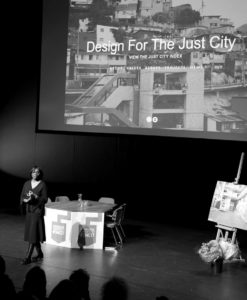
Other such frameworks circulate in architecture and urban design as measures of community success, most often with fewer criteria. Griffin finds those too limited. “If you are not those ten or 15 things, then you are not living up to the aspiration of [their] framework,” she says. With its 50 entries, the Just City Index aims to cast a wide net and let participants choose and prioritize the values they think apply to their particular condition of injustice. The real difference is the starting point. Most such frameworks begin with the designers. The Just City Index instead empowers its users, allowing them “to assign themselves the values that are most important for them and that are needed to address the conditions of injustice on the ground at that moment in time.” Just City Lab researcher Natasha Hicks comments: “The beauty of the index [is that] it’s an accessible tool that communities can use to create a shared values system.” The Just City Index is a foundational tool for study in Patterned Justice: Design Languages for a Just Pittsburgh, and plays an increasingly integral role in Griffin’s work.
The other tool for Patterned Justice: Design Languages for a Just Pittsburgh is Christopher Alexander’s book, A Pattern Language, an eccentric classic first published in 1977. It identifies conditions that make spaces more welcoming, comfortable, and useful. Alexander’s patterns are vignettes of common-sense design–active shopping streets and houses with sheltering roofs; offices with windows and benches with good views–rather than complex or prescriptive forms. A Pattern Language covers scales from large to small–“towns and neighborhoods, houses, gardens, and rooms”–with nested interrelationships from one scale to the next. With 253 chapters, it is more effective as a reference than a narrative, but the language, says Laura Greenberg, a Master’s student in the Pittsburgh studio, “is easily accessible to people. It’s not in any kind of design jargon.” Alexander’s late-hippie egalitarianism meshes well with Griffin’s emphasis on inclusivity and diversity. “[T]owns and buildings will not be able to come alive,” Alexander writes, “unless they are made by all people in society, and unless these people share a common pattern language, within which to make these buildings.”
Griffin’s Pittsburgh studio engages four different sites: The Hill District is a traditionally black community that has a rich history, but has faced decades of struggle after being decimated by urban renewal projects in the 1960s. East Liberty and Garfield are neighborhoods where rapid redevelopment is causing gentrification. Beechview is a traditionally white working-class neighborhood where the Latinx population is growing but redevelopment is slow. And Hazelwood, with the massive Hazelwood Green redevelopment just beginning, is about to undergo significant change.
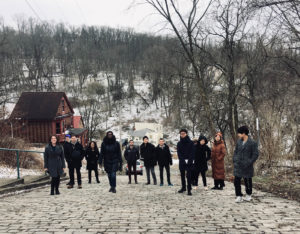
The combination of the Just City Index and A Pattern Language leads to expectedly principled-yet-amorphous patterns at a variety of scales. In a studio of twelve students, each one is responsible for producing four or five patterns. Greenberg’s are exemplary for their variety. She documents “a pattern of school vacancy which looked at closings of public schools from 2006 through 2012 and noting that nearly 70% of public schools in majority-black neighborhoods were closed, versus 20% in majority-white neighborhoods. There is still a large number of schools that remain vacant, especially in black communities, and the ones that have been redeveloped tend to be targeted for luxury condos, and don’t replicate the public good that a public school creates.”
Another pattern arising from the studio is that of the so-called “porch stigma” faced by residents in Hazelwood and other Pittsburgh communities who may have less of an ability to maintain their porch, or who use their porches in ways that run counter to dominant standards of urbanism. These factors leave residents vulnerable from a legal perspective to 2006 and 2009 porch furniture ordinances, as well as the stigma that surrounds a porch that doesn’t adhere to institutionalized norms.
By May, these patterns will take their final form, a pattern book describing policy, program and design strategies. Though she has a portfolio of tangible projects, evidenced in the “Design and the Just City” exhibit, Griffin emphasizes the roles of process and enfranchisement as true determinants of meaningful change. She says, “When I can step back and see that there are multiple types of leaders of the community having real ownership of both the process and the outcomes, that is success.”
On Thursday, April 11, 2019, Toni L. Griffin will join Rip Rapson, president of the Kresge Foundation, and urban planner and designer Maurice Cox in a discussion about the complex design, economic and political innovations required to create transformational change for Detroit.
Diane E. Davis speaks on the power of design schools to shape local communities
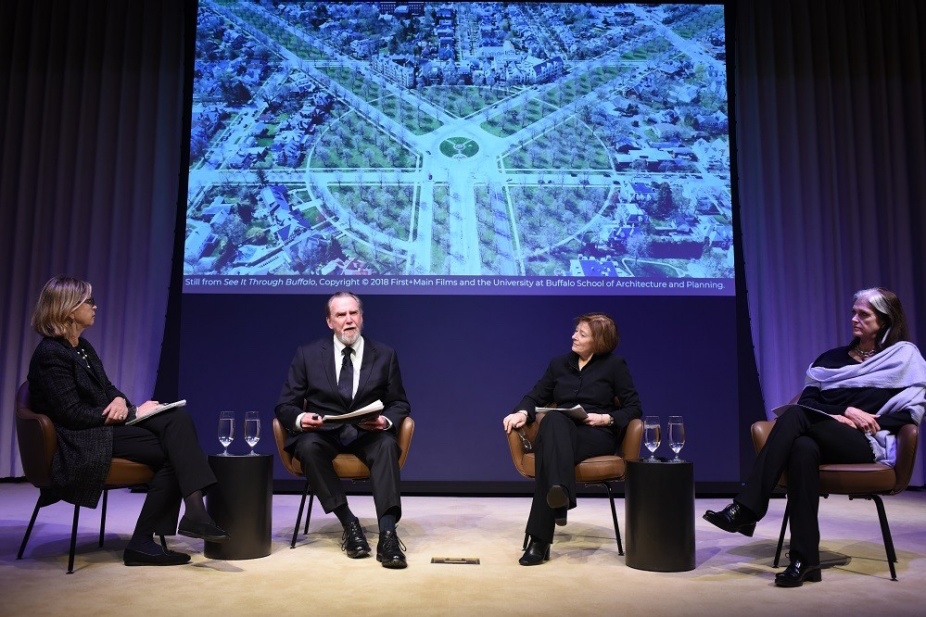
The Harvard Graduate School of Design’s Diane E. Davis joined fellow design-school leaders from the University of Buffalo last month to discuss how their various programs both contribute to and benefit from their local communities. Davis spoke alongside Deborah Berke, dean of the Yale University School of Architecture, and Robert Shibley, dean of the University of Buffalo (UB) School of Architecture and Planning, in a March 21 panel moderated by Architectural Record editor Cathleen McGuigan and held at the Ford Foundation in New York City.
The panel followed a screening of “See It Through Buffalo,” a cinematic tribute to that city’s urban landscapes and transitioning neighborhoods, produced by UB’s School of Architecture and Planning and exhibited during the 2018 Venice Architecture Biennale. The film helped frame a discussion of the dynamics of community engagement and how a design school might interact with the urban context in which it’s situated.
Davis has served as chair of the GSD’s Department of Urban Planning and Design since 2015. During the March 21 panel, Davis spoke to the GSD’s metropolitan Boston surroundings, in which, she observed, a relatively compact urban size coupled with complex city-region dynamics mean students must work at smaller scales.
“Boston is a divided city and region, with pockets of poverty and neglect,” she said. “We have to teach our students to think strategically with acupunctural interventions rather than comprehensive interventions.”
Davis also noted GSD programs like the recently announced Community Design and Learning Initiative, as well as fellowships that enable students to exercise their design and planning know-how while serving at-need local communities.
“You become a better architect and designer by knowing one place well,” Davis said. “It’s a special opportunity for students who care about changing the cities they live in to go to an institution that has that partnership.”
Davis’s observations harmonized with those from deans Berke and Shibley. Berke noted a partnership between a Yale School of Architecture housing studio and New Haven housing nonprofit Columbus House, in which intensive community engagement was instrumental to siting and designing a house for the studio to build.
“As important as it was to build the house,” Berke said, “seeing how the machinations of community engagement work with the planning process was probably the more valuable lesson.”
“Multiple Miamis” presents the city’s multiple personalities, with lessons for cities across the country

The sunset orange that frames “Multiple Miamis” gradually deepens as the exhibition progresses, a gesture that its curators hope is both evocative and objective—a tropical palette appropriate for Miami, but that resists prioritizing any one of the range of ideas and projects presented. As its name suggests, the exhibition presents Miami as the site of multiple overlapping cities grappling with a complex network of social issues.
“Multiple Miamis,” now on view in the Frances Loeb Library, follows a Harvard Graduate School of Design option studio by the same name, led by Sean Canty and Chris Reed. The studio took up a tale familiar to the American city—neighborhoods reshaped by decades of redlining and segregation, often leading to disinvestment and disrepair—and examined how this narrative has played out in the Miami neighborhood of Overtown.
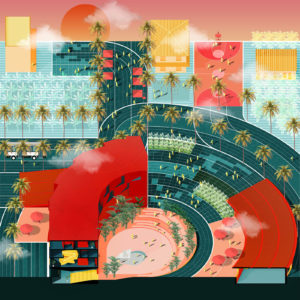
“The studio and exhibition present an opportunity to focus on a set of issues that are relevant to many large-scale American and global cities today,” Reed says. “And even though we took on some tough social issues, the key was to do so through the tools that designers have.”
The “Multiple Miamis” exhibition draws from the studio’s months of dialogue and design iteration, punctuated by a week-long site visit in October, 2018, in which students met with local government officials, community organizations, and residents. Canty and Reed curated the exhibition alongside two of the studio’s participating students, Ting Liang (MLA/MAUD ’19) and Zishen Wen (MLA ’19).

Like the “Multiple Miamis” studio, the exhibition explores questions of inequity, race, affordability, and resilience, and how policy and the built environment shape or complicate them through housing, transit, and other infrastructure. The studio examined in depth how models of urban development might better support underserved communities.
Near the downtown area, Overtown is home to a predominantly black population and has one of Miami’s lowest median household incomes. Overtown’s cultural fabric was torn by two interstate highway projects in the 1960s. Today, the effects of real estate speculation and boom in greater Miami, coupled with a warming climate and subsequent sea level rise, have compounded the pressures faced by the neighborhood.
It’s a pattern that emerges throughout the Miami area, in inland neighborhoods like Little Haiti, Liberty City, and Allapattah, and in other American cities facing questions of affordability and displacement. When juxtaposed with Miami’s rosier, palm-tufted representations, these patterns can generate a complicated, even distorted reality.
The “Multiple Miamis” studio’s output takes varied approaches to these questions, pursuing ideas that respond specifically to Overtown’s—and Miami’s–context and culture, but that might be applicable to other regions or cities.
The installation’s entrance wall greets viewers with a showcase of study models, revealing glimpses of the studio’s process and iteration as participants steeped themselves in Overtown’s historical and current social issues.

“It’s an entire display of possibilities,” Reed observes, embedded with quintessentially Miami details. Dominant themes include the hybridization of building, landscape, and infrastructure types—affordable housing or a parking garage mixed, for instance, with a park in a unified project.
Several projects look at how to densify and diversify housing choices on existing sites, some of which have been individual and privately-owned, others larger and publicly-owned—but with an emphasis throughout on providing useful, productive outdoor spaces, taking advantage of Miami’s favorable year-round climate. Many of these housing-driven projects also respond to today’s evolving, often hybridized family configurations and living situations.
Other emergent themes include resilience in the face of climate change, as well as a rethinking of housing as a public good rather than as a market-dictated commodity. Transit also looms large in “Multiple Miamis”: Several projects propose extending transit lines or establishing new transit stops, orienting the additions as the center of a redevelopment strategy. Transit options not only become closer and more accessible to users, but can be leveraged to create new, connective open spaces, as well as housing and mixed-use opportunities.

“Since the studio really leveraged different parts of the school, there’s a little something for everyone to look at and think through,” Canty says.
Liang and Wen proposed “Ephemeral City,” which holistically examines Overtown’s physical fabric, then recontextualizes it within a more urbanistic framework. This embeds the neighborhood with “ephemeral moments,” Liang says, that are in tune with social needs.
The studio’s models generate a physical and pedagogical constellation that illustrates the diversity of disciplinary approaches. As viewers move through the installation, they follow the studio’s conceptual progress, reaching final models at the show’s rear wall. A third component presents policy and reading material culled from the studio’s concurrently run urban planning and design seminar, led by Lily Song.
While “Multiple Miamis” grapples with heady, pressing issues, it also suggests that collaborations between design fields is integral to enhancing urban equity and resilience.
“In gathering and discussing work during such an interdisciplinary studio, I grew much more open to new ideas and was able to generate new possibilities for solving such persistent issues,” Liang says. “From philosophy to methodology, there’s always so much to learn from other fields.”
Keep reading about the course Multiple Miamis: Infrastructure, Affordability, Identity & the Public, learn more about the exhibition “Multiple Miamis,” or watch a work-in-progress video about Ting Liang and Zishen Wen’s “Ephemeral City.”
A Pattern Language: A user’s guide to the seminal architectural handbook
“A complex of buildings with no center is like a man without a head.” This sentence conveys the ethos of A Pattern Language (1977), the instructional tome written by architect, design theorist and Harvard Graduate School of Design alumnus Christopher Alexander (PhD ’63) along with five of his colleagues at the Center for Environmental Structure at the University of California, Berkeley. The bestselling architectural handbook is itself in many ways a man without a head: a sprawling guide to building and planning that has seen renewed relevance lately as a model for marrying physical spaces with ideological frameworks.
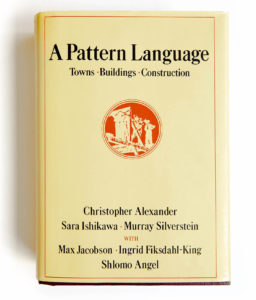
A Pattern Language lays out over 1,100 pages how our buildings—and by proxy our cities—are not entities at a remove from human beings, but rather their manufactured extensions. And as with any body (headless or otherwise), the whole structure is only as healthy as its individual parts. No facet of our cities and towns should be unwelcoming to their citizens, and no room in a house should feel neglected. A space should “feel right,” the authors argue, and that feeling is tied to the congruence between physical and social spaces.
Separated into three sections, Towns, Buildings, and Construction, the book contains 253 patterns defined as “problem[s] which occur over and over again in our environment.” Problems like how to orient the rooms in a home around naturally-occurring light and dark, so that the flow of movement “guides people toward the light whenever they are going important places: seats, entrances, stairs, passages, [and] places of special beauty.” Or the problem of the lack of intimacy between couples when children are present. “Their role as parents rather than as a couple permeates all aspects of their private relations.” The solution: the creation of a private “couple’s realm… a world in which the intimacy of the man and woman, their joys and sorrows, can be shared and lived through.”
For each of the archetypal facets of our homes and communities, the authors offer a solution for living well in the form of gentle-yet-pointed advice that can be adapted to individual circumstances. This in turn creates a diagnosis-and-solution rhythm that continues throughout the dense—if charming, and frequently idiosyncratic—book. Not every pattern will be useful or applicable to every individual home or community, the authors point out, but a good portion could potentially be—every home has a main door; every city has a system of roads—and how they build off of and influence each other will determine the unit’s health.
Every society which is alive and whole will have its own unique and distinct pattern language. Every individual in such a society will have a unique language, shared in part, but which as a totality is unique to the mind of the person who has it. In this sense, in a healthy society there will be as many pattern languages as there are people—even though these languages are shared and similar.
A Pattern Language
The authors are primarily concerned with the alienating effects of poor architecture and design, which leads them to recommend means by which life at work—as well as in the city and at home—involves contact with others. With entries such as 140. Private Terrace on the Street, the authors aim to facilitate happiness and tranquility by virtue of a delicate fusion of public and private areas. When combining this goal with an equally emphasized desire to put humans in constant proximity to nature, they demonstrate their focus on physical and mental wellbeing in the form of a balance between social interaction and Zen-like serenity. For this reason, Modernism and Classicism alike have no place in these pages, as their aesthetic and philosophical foundations, the authors imply, have little concern for their inhabitants’ health.
A Pattern Language, in large part due to its encyclopedic nature, stimulates introspection and healthy debate about what environments, both personal and professional, we currently inhabit and how they might be improved. One can cast aside the given prescriptions at will, but Alexander and his coauthors encourage readers to contemplate their reactions to nearly every aspect of the built environment.
A Pattern Language has been used as a reference in research and coursework at Harvard’s Graduate School of Design. Continue reading about Toni L. Griffin’s 2019 course Patterned Justice: Design Languages for a Just Pittsburgh and the Rouse Visiting Artist Lecture by Fritz Haeg, Nils Norman, and Julieta González.
The Inaugural Eduard Sekler Scholarship Recipient: Francisco Colom
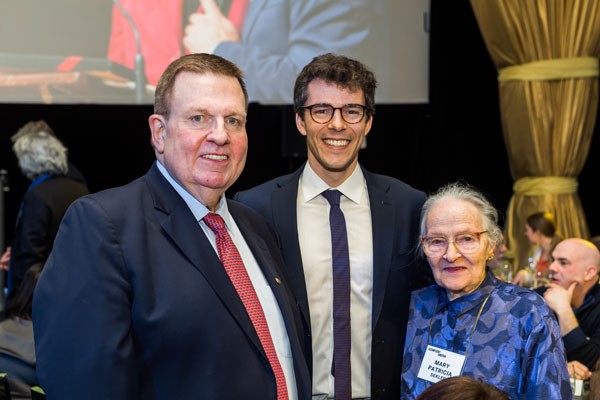
As the first Eduard Sekler Fellow, Francisco Colom (MDes ’19) is embracing the legacy of the beloved Professor Sekler through his work in conservation and the tensions between progress and tradition. Colom is an architect, urban designer, and Master in Design Studies (MDes) candidate at the Harvard University Graduate School of Design (GSD). Eduard Franz Sekler served on the Harvard University faculty for more than 50 years at both the GSD and the Faculty of Arts and Sciences. Among his numerous achievements was co-founding the Department of Visual and Environmental Studies and advocating for the preservation of cultural and architectural sites around the world.
The Eduard Sekler Fellowship Fund was created to honor Professor Sekler’s legacy at the GSD. Mick Doyle (MArch ’77), who first met Professor Sekler as a GSD student, then teaching assistant, and who maintained a life-long friendship and association with Professor Sekler through projects including the Kathmandu Valley Preservation Trust, led the effort. A broad range of alumni and friends supported the fellowship, and a significant contribution from Dr. Ellen Phoebe “Epi” Wiese (PhD ’53, PhD ’59) ensured the Eduard Sekler Fellowship Fund at the GSD in perpetuity.
Sekler’s passion for preservation lives on in the work of Colom and his MDes concentration of Critical Conservation, which provides designers, real estate professionals, planners, and others with a foundation to understand the cultural systems that frame conflicts inherent in making progressive places. Colom’s research focuses on embedded and temporal cultural systems, the tensions between progress and tradition, and the way clashes of meaning and identity are registered by the built environment. His thesis considers the Maison Tropicale, a prefabricated housing system originally designed by architect Jean Prouvé to address the shortage of housing in French colonies in West Africa during the 1950s and how Western media and institutions use modernist architecture as a tool for cultural domination today. Colom serves as Teaching Assistant for the course “Conservation, Destruction, and Curating Impermanence” and is the editor of More Than Green, a project directed by a platform of professionals and academicians that promotes a holistic understanding of sustainability in the urban environment.
“By awarding me the Sekler Fellowship, you have lightened my financial burden which allows me to focus more on the most important aspect of school, learning,” wrote Colom to Pat Sekler (AM ’58, PhD ’73, BF ’76). He continues: “I will work very hard to make the most of this opportunity. Thank you again for your generosity and support.”
Colom received his Master of Architecture degree with honors from the University of Alicante in Spain and was appointed Honorary Professor of the Department of Architectural Design. Professional highlights include a diverse range of architectural and urban projects in the Netherlands, Spain, Azerbaijan, the United Arab Emirates, and the United States. His work has been exhibited at the 15th and 16th Venice Architecture Biennale and his academic research grants include the Fundacion La Caixa Fellowship, the European Union Tempo Project Scholarship, and the Harvard GSD Community Service Fellowship. For his GSD Community Service Fellowship, he joined MASS Design Group, co-founded by Alan Ricks (MArch ’10) and Michael Murphy (MArch ’11), as a Community Service Program Fellow working in support of their mission of researching, building, and advocating for architecture that promotes justice and human dignity. His projects included collaborating on a project for the holistic improvement of a vulnerable neighborhood in Asuncion, Paraguay, in which community participation strategies were central to the design process and designing an education center to complement the program of a hospital in Monrovia, Liberia.
After graduation, Colom plans to work with fellow student Maclean Sarbah (MDes ’19), with the aim of finding and applying design strategies where they can potentially be most beneficial. They began the partnership with a trip to Sarbah’s native Ghana during which they reflected on the ways design can make a positive impact in the lives of people when introduced collaboratively and sensitively.
The GSD joins with Francisco Colom and the future Sekler Fellows in thanking the many alumni and friends whose generous contributions helped to establish this enduring financial aid award in memory of the incomparable Professor Eduard Sekler.

